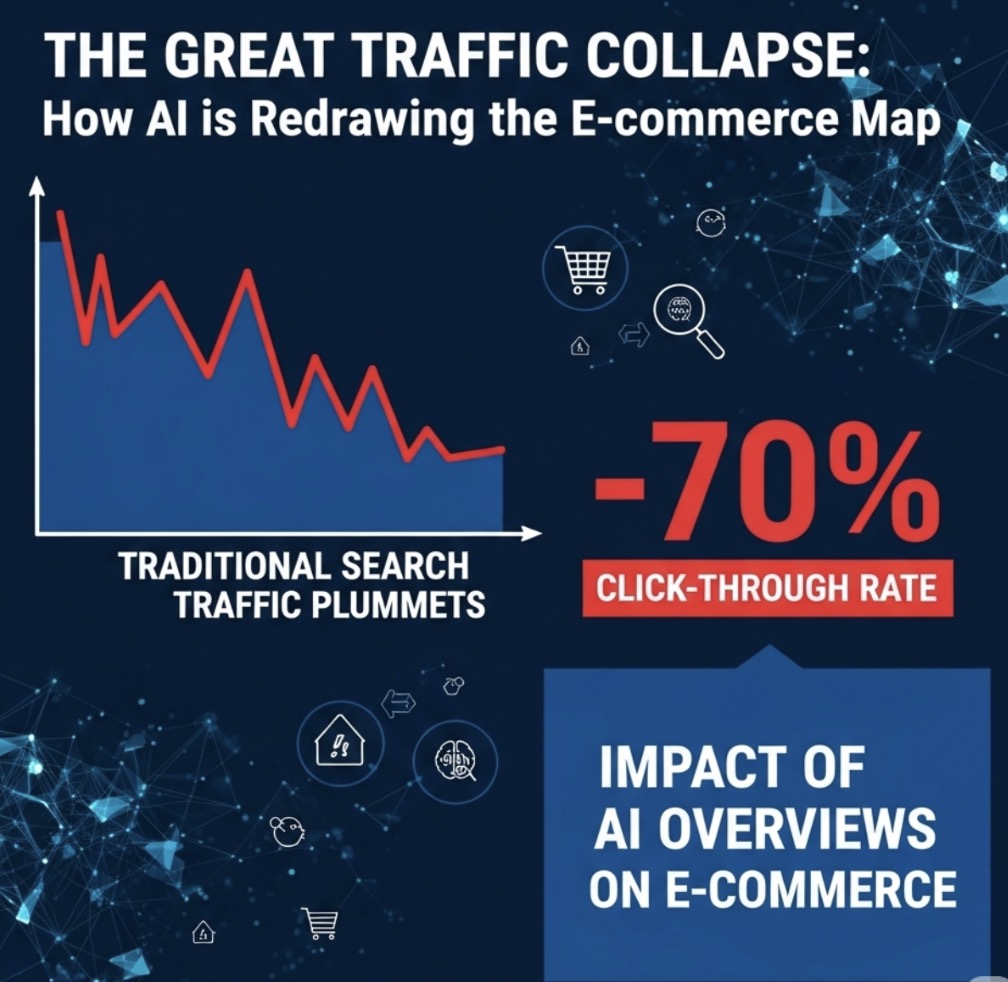The foundational principle of the commercial web, an implicit contract that has governed digital strategy for two decades, is broken. This contract was simple: creators and businesses would produce valuable, high-quality content, and in exchange, search engines would deliver qualified traffic. This symbiotic relationship, the very engine of the referral economy, has not just been disrupted; it has collapsed.
We are not witnessing a period of gradual evolution. We are in the midst of a systemic failure of the referral-based web economy, a paradigm shift that renders the old playbooks for digital visibility and customer acquisition dangerously obsolete. For any business built on the promise of organic search traffic, this is an existential crisis.
 The great traffic collapse: impact of AI Overviews on e-commerce click-through rate
The great traffic collapse: impact of AI Overviews on e-commerce click-through rate
The primary symptom of this collapse is the rise of the "zero-click" search engine results page (SERP). For years, the goal of Search Engine Optimization (SEO) was to secure a high-ranking position that would entice a user to click through to a brand's website. That click was the currency of the digital economy. Today, that currency has been devalued to the point of irrelevance. A majority of searches conducted on dominant platforms like Google no longer result in a click to an external website. This is not an anomaly; it is the new default user behavior.
Data from across the industry paints a stark and undeniable picture:
This phenomenon is the result of a deliberate, long-term strategy by search engines to transform their results pages from a directory of links into a destination in and of itself. Through features like knowledge panels, direct answers, and featured snippets, search engines have systematically trained users to expect answers directly on the SERP, obviating the need to visit the source websites that provide the underlying information.
What was once a gateway to the broader web has become a walled garden, and the walls are getting higher every day.
If the zero-click SERP was the initial shock to the system, the widespread rollout of Google's AI Overviews is the aftershock that is leveling what remains of the old structure. Introduced in 2024, this feature uses generative AI to synthesize information from multiple web sources into a single, comprehensive summary displayed at the very top of the search results. While positioned as a user-centric innovation, its impact on publisher and e-commerce traffic has been nothing short of catastrophic.
Multiple independent studies have quantified the devastating effect on click-through rates (CTR):
Perhaps more alarming is the user behavior associated with the AI-generated summaries themselves. The summaries often contain links to the sources from which the information was synthesized, a feature Google points to as evidence of its continued commitment to the web ecosystem. However, user data tells a different story:
This indicates that the AI-generated answer is often perceived as "good enough," terminating the user's journey of discovery.
To fully grasp the magnitude of this economic shift, one must look beyond clicks and examine the underlying behavior of the new agents shaping the web: AI crawlers. These are the automated bots sent out by companies like OpenAI, Anthropic, and Google to gather the data needed to train their large language models (LLMs). Their behavior reveals the new, deeply asymmetrical relationship between content creators and AI platforms.
A useful metric to understand this asymmetry is the "crawl-to-referral ratio"—the number of pages a bot consumes from a website for every one visitor it sends back:
This is not a partnership; it is a data mining operation on an industrial scale. The old model valued a website for its ability to attract and convert human traffic. The new model values a website as a raw data source, a quarry to be mined for the linguistic and factual material needed to build a competing intelligence.
This dynamic creates a lose-lose scenario for content creators and businesses:
The impact is not uniform across all query types. To date, informational queries—those seeking answers to questions like "what is," "how to," or "why"—have been the most severely affected, with data showing that 88% of all AI Overviews are triggered by such searches.
Transactional and e-commerce queries have, for now, been less impacted. This is a critical distinction and a point of dangerous complacency for many online retailers. The technology is being perfected on informational content, but its eventual, inevitable application to commercial queries is not a matter of if, but when.
The economic incentive that fueled the creation of the rich, diverse, and high-quality content that has powered the web for two decades is collapsing. This is not an evolution of SEO. It is a fundamental economic disruption that demands an entirely new strategy for survival and growth.
Traditional SEO tactics—keyword optimization, link building, content marketing—were designed for a world where search engines needed your content and rewarded you with traffic. That world no longer exists. In its place is a new reality where AI systems consume your content without compensation and answer user queries without attribution.
The question is no longer how to rank higher on Google. The question is how to ensure your business survives and thrives in a world where Google may no longer be the primary gateway to your customers.
This is part 1 of our 7-part series on AI Visibility and the future of e-commerce. In the next article, we'll explore how Gen Z is abandoning Google for TikTok, Reddit, and ChatGPT—and what that means for your marketing strategy.
Ready to learn more? Download the complete AI Visibility white paper for the full playbook on surviving and thriving in the post-search era.